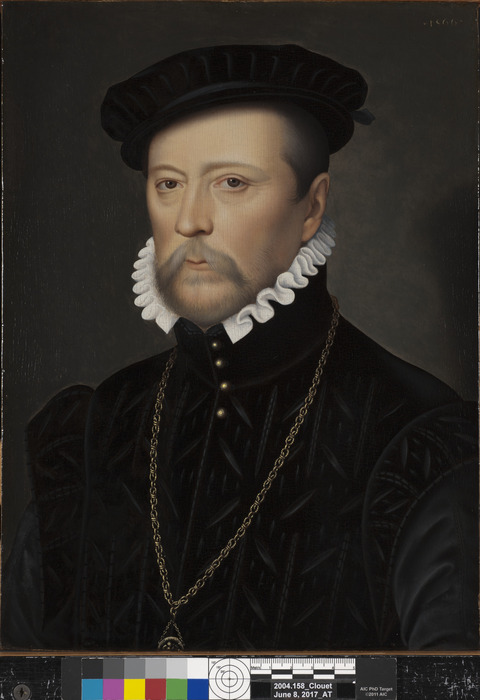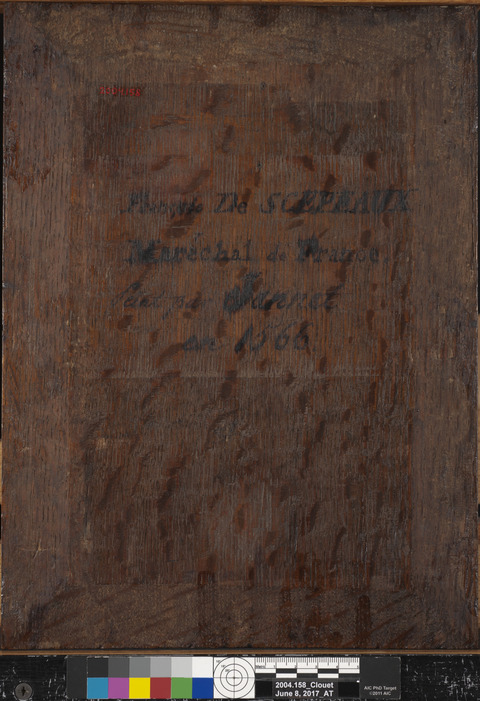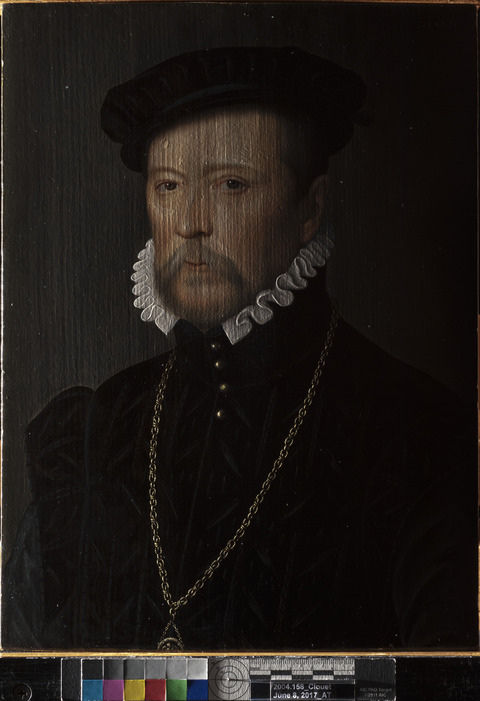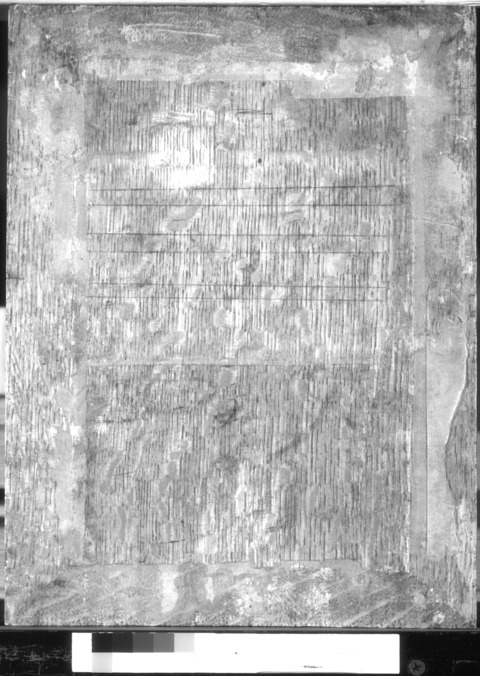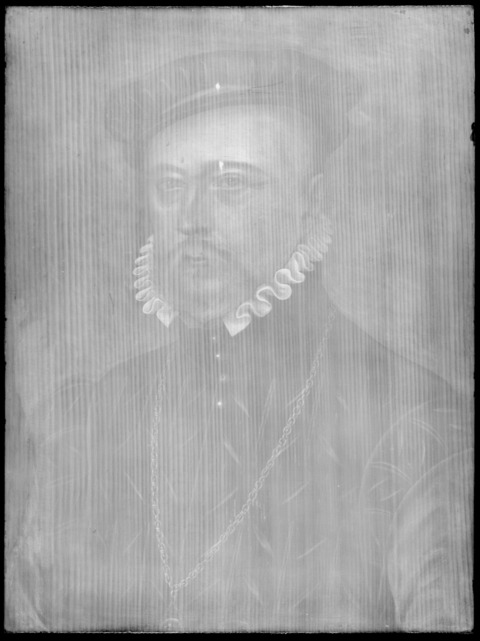Overview
Accession number: 2004.158
Artist: Franҫois Clouet and Workshop
Title: Portrait of François de Scépeaux
Materials: Oil (untested) on Baltic oak panel
Date of creation: 1566
Previous number/accession number: C10020
Dimensions: 31.6 × 23.4 cm
Conservator/examiner: Erica Schuler
Examination completed: 2017
Distinguishing Marks
Front:
Item 1. The date “1566” is painted in yellow in the top-right corner.

Back:
Item 2. An inscription, written in a fluid, black, infrared-transparent medium (tech. fig. 2), is inscribed between carbon-based (graphite?) guidelines (tech. fig. 3). The inscription reads “Franc̗ois De SCEPEAUX / Maréchal de France. / peint par Jannet / en 1566.”
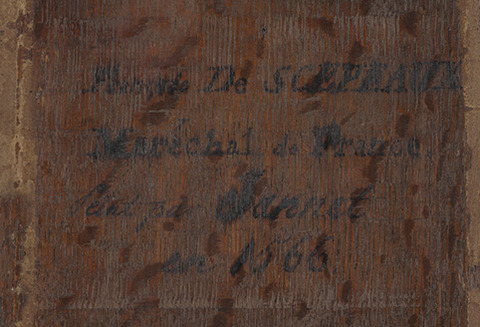
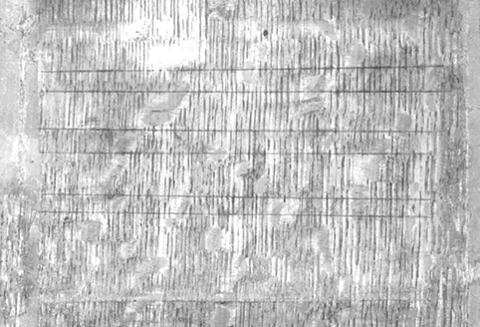
Additional:
Item 3. Gallery label: “NEWHOUSE GALLERIES / INCORPORATED / PAINTINGS / 15 East 57TH St. / NEW YORK 22, N.Y.” (tech. fig. 4).
Item 4. Gallery Label: “NO. 14732 SIZE 121/2X91/4 / PORTRAIT OF FRANCOIS DE SCEPEAUX / MARECHAL DE VIEILLEVILLE / TITLE / FRANCOIS CLOUET / 1522 ARTIST 1572” (tech. fig. 4).
Item 5. Clowes fund collection label: “THE CLOWES FUND, INCORPORATED / FINE ARTS DEPARTMENT / 3744 SPRING HOLLOW ROAD / INDIANAPOLIS 8, INDIANA, U.S.A. / No. 11. CLOUET / PORTRAIT OF FRANCOIS DE SCEPEAUX” (tech. fig. 4).
Item 6. Offwhite paper label: “No. 6 – Francois Clouet / Portrait of Francois de Scepeaux / TR. 10020” (tech. fig. 4).
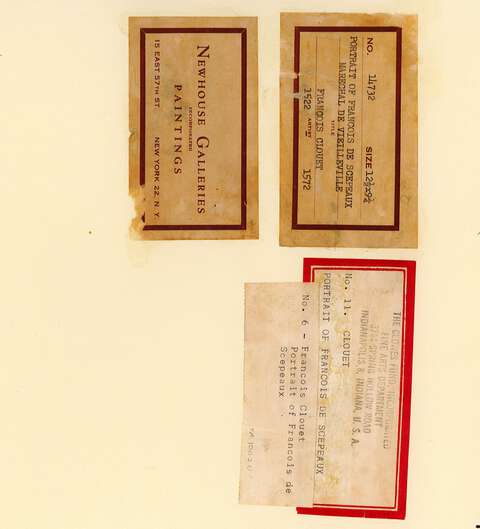
Summary of Treatment History
Records detailing treatment before 1971 have not been retained; however, visual examination aided by magnification, X-radiography, and infrared reflectography confirm that earlier treatment campaigns were executed on the painting. Given that the support is in very good condition and shows no sign of structural intervention, it is likely that past treatment focused primarily on the painting’s aesthetics. Anomalous mechanical cracks beneath the sitter’s proper right eye, three small areas of compensation within the sitter’s proper right forehead, and disrupted impasto of the yellow paint used to denote buttons on the tunic indicate that stabilization of the picture layer was also carried out. Past treatment campaigns likely included varnish clearance/reduction, consolidation, loss compensation (fills), retouching, and varnish application.
Documentation suggests a series of condition assessments and treatments were carried out on the collection around the time the works were moved from the Clowes' residence to the IMA collection in 1971. A condition report by Paul Spheeris in October of that year, likely carried out before the paintings were relocated, described the painting as having a “heavy natural resin varnish that is creating an undue amount of surface tension that could possibly cause cupping of the paint layer”. He recommended removal of the varnish to remedy this and enhance the appearance of the painting. He also noted a scratch in the middle of the right side of the painting.1
A second condition assessment was carried out upon arrival of the paintings at the IMA. This assessment describes the work as being in “good condition” and no work was deemed necessary. An X-radiograph of the painting was made at this time.2 In 1974, condition assessment, treatment, and investigation of the collection was carried out by the Intermuseum Conservation Association at Oberlin College. This document describes this painting as having a “natural resin varnish, dirty and finger-marked.” A superficial clean and recoat was recommended in addition to the application of a moisture barrier to the back of the painting. A memorandum explaining the charges for this work suggest the recommended work was indeed carried out.3 In 1996, a memorandum summarizing treatment and examination of the Clowes Collection from the time it entered the collection stated that a surface clean and surface coat were carried out in 1982.4 Further information about this treatment suggest a mild solvent was employed to clear a “dark yellow residue” from the surface and multiple coats of varnish subsequently applied to presumably brighten and saturate the composition.5
The condition was again recorded in November 2004 by the IMA for gift consideration and has been documented annually from 2011 to 2020 as part of the Clowes Collection annual survey. Dendrochronological analysis of the panel was completed by Peter Klein in 1999 (see Description of Support).
The painting was most recently conserved by Erica Schuler in 2017. The primary focus in executing this treatment was to achieve an even appearance of the markedly crazed and degraded varnish film. A coating identified in the treatment report as “Renaissance Wax” was removed using naphtha. The underlying varnish was then removed using acetone. A previous retouching campaign was removed along with the varnish layer. A second retouching campaign underlying the varnish was left in place, as it was restricted to areas of fill and was not disfiguring. Cleaning proved extremely successful in clearing the disfiguring varnish to reveal the original paint surface. The application of a new barrier layer of Paraloid B-72 and final varnish layers of MS2A successfully saturated the colors and restored clarity to the compositional design.
Current Condition Summary
The painting is executed on a single oak panel that is in very good condition: no signs of past structural intervention were observed on the support, and the panel’s original dimensions and beveled edges (back) have been preserved. The panel shows a slight convex warp along the vertical grain, but both the support and the picture layer remain secure. After the 2017 conservation treatment, the painting exhibits excellent aesthetic unity. The varnish is clear and saturates the paint layer even in the dark passages of the man’s clothes. An extensive network of age craquelure extends through the ground, paint, and varnish, and small pinpoint losses exist around the periphery. Despite these issues, adhesion of the paint to the panel and cohesion throughout the strata remain secure with no observed evidence of incipient delamination.
Methods of Examination, Imaging, and Analysis
| Imaging | Surface analysis (no sample required): | Analysis (sample required): |
|---|---|---|
| Unaided eye | Dendrochronology | Microchemical analysis |
| Optical microscopy | Wood identification | Fiber ID |
| Incident light | Microchemical analysis | Cross-section sampling |
| Raking light | Thread count analysis | Dispersed pigment sample |
| Reflected/specular light | X-ray fluorescence spectroscopy (XRF) | Fourier-transform infrared spectroscopy (FTIR) |
| Transmitted light | Macro X-ray fluorescence scanning (MA-XRF) | Raman microspectroscopy |
| Ultraviolet-induced visible fluorescence (UV) | ||
| Infrared reflectography (IRR) | Gas chromatography–mass spectrometry (GC-MS) | |
| Infrared transmittography (IRT) | Scanning electron microscope -energy dispersive X-ray spectroscopy (SEM-EDS) | |
| Infrared luminescence | Other: | |
| X-radiography |
Technical Examination
Description of Support
Analyzed Observed
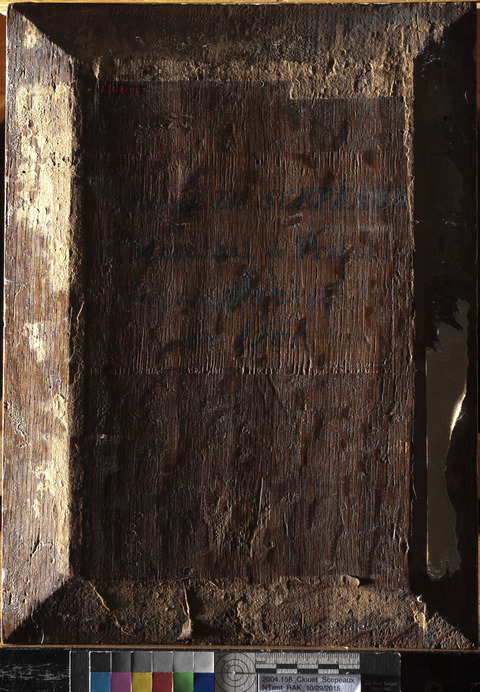
Material Type (fabric, wood, metal, dendrochronology results, fiber ID information, etc.):
The wood support is comprised of a single radially cut oak plank that measures 31.6 × 23.4 × 1.2 cm. Each edge of the board’s back is beveled to a thickness of 0.5 cm (tech. fig. 5). The prominent growth rings along the end grain support the findings of Peter Klein’s dendrochronological analysis in which he identified the wood as a single oak panel containing 112 growth rings and originating from the Baltic/Polish region. Klein dated the rings between 1517 (formation of the youngest heartwood ring) and 1526. With a minimum of two years for seasoning, the terminus post quem of the painting would be 1528. However, Klein estimated a more likely date for the painting would be after 1534.6
Characteristics of Construction/Fabrication (cusping, beveled edges of panels, seams or joins, battens):
The panel is composed of a single radially sawn board with vertically oriented grain. The panel retains its original thickness of 1.2 centimeters and each edge is beveled on the back to a thickness of 0.5 cm. In addition to anatomical characteristics of the wood structure (irregular radial bands show as contrasting, dark, mottled patches—ray fleck—on the plank’s back), shallow and uniformly spaced vertical and horizontal ridges created by hand tools (likely chisel and wood plane) during the final finishing stages of construction can be seen under extreme raking illumination.
Thickness (for panels or boards):
Each edge is beveled on the back to a thickness of 0.5 centimeter.
Production/Dealer’s Marks:
No production or dealers' marks were observed.
Weave (structure, weight, thread thickness, etc):
Not applicable
Auxiliary Support:
Original Not original Not able to discern None
The back appears unaltered from its original construction, and the panel has not been stabilized by the addition of an auxiliary support.
Condition of Support
The oak panel is in very good structural condition. Despite the presence of prominent vertical craquelure throughout the picture layer, no evidence of cracks or splits was observed in the wood support. The panel exhibits a slight convex warp along the vertical wood grain of approximately 0.5 cm at the painting’s center, which is an inherent aging response of the wood to its environment. The original dimensions, tool marks, beveled edges, and inscription on the back have been preserved. Residual kraft paper and adhesive from a past framing campaign is adhered to the bevels.
Description of Ground
Analyzed Observed
Materials/Binding Medium:
Significant peaks for both lead and calcium were recorded during the XRF analysis of exposed ground within the painting’s top proper right corner (see Table 1; sample 1). Lead was identified throughout the composition. XRF data combined with visual characteristics of the layered structure observed under low-power magnification suggest that the panel was prepared with at least two priming materials—a ground followed by a lead white-rich imprimatura. A layer of size was likely applied to the wood followed by the calcium-containing ground likely bound in glue. Over the ground, a thin imprimatura layer, probably rich in lead white and bound in an oil-based medium, was applied. Given the painting’s attributed Northern European origins, it is expected that the initial preparatory layer is a chalk-based (calcium carbonate) ground. Further analysis is necessary to confirm the particular layer structure of the materials.
Color:
Exposed ground observed within crack apertures and losses appears to range from white to off-white in color.
Application:
Given the smooth, uniform appearance of the painting’s surface under normal viewing conditions, the principal ground was likely brush applied in an even layer(s), then smoothed with a scraper or an abrasive material before the white finishing layer was applied with a fine-bristled brush.
Thickness:
The ground appears moderately thick. It sufficiently masks the vertical texture of the wood grain under normal illumination, but the grain and vertical craquelure are noticeable when the painting is viewed under extreme raking light.
Sizing:
Direct observation without analysis cannot confirm the presence of size; however, given documented panel preparation techniques of the period, it is extremely likely that the wood was sized with multiple layers of animal glue prior to the application of the ground.
Character and Appearance (Does texture of support remain detectable/prominent?):
The ground is moderately thick with prominent vertical age cracks. Despite the overall smooth appearance of the painting’s surface under visible light, under specular and raking light conditions, both the linear texture of the wood grain and the craquelure become markedly visible.
Condition of Ground
The ground overall displays prominent age craquelure with minor associated past losses. Insecurities were addressed through consolidation, compensation, and inpainting, and at present the ground is in good condition and shows good adhesion to the support with no sign of incipient cleavage or flaking. The craquelure pattern consists of an ordered network of predominately vertical cracks following the wood grain linked by secondary fine horizontal cracks that create long, narrow, rectangular islands of paint (tech. fig. 6). All cracks appear to extend through the ground and paint layers, and aside from three minor areas of compensation within the sitter’s proper right forehead7 and general pinpoint losses around the periphery, no additional passages of associated loss were noted during this examination. Additionally, the X-radiograph reveals two moderate mechanical scratches that appear to extend through the picture layer, one in the center of the hat and the other in the background to the left of the sitter’s chin.
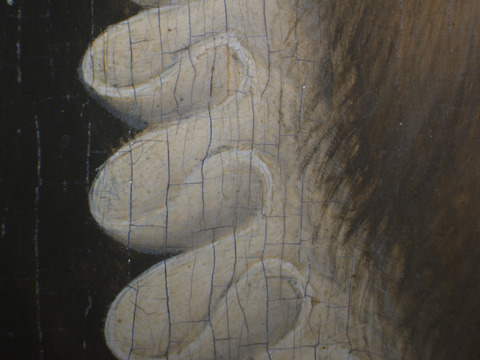
Description of Composition Planning
Methods of Analysis:
Surface observation (unaided or with magnification)
Infrared reflectography (IRR)
X-radiography
Analysis Parameters:
| X-ray equipment | GE Inspection Technologies Type: ERESCO 200MFR 3.1, Tube S/N: MIR 201E 58-2812, EN 12543: 1.0mm, Filter: 0.8mm Be + 2mm Al |
|---|---|
| KV: | 21 |
| mA: | 3 |
| Exposure time (s) | 120 |
| Distance from x-ray tube: | 36” |
| IRR equipment and wavelengths | Opus Instruments Osiris A1 infrared camera with InGaAs array detector operating at a wavelength of 0.9–1.7µm. |
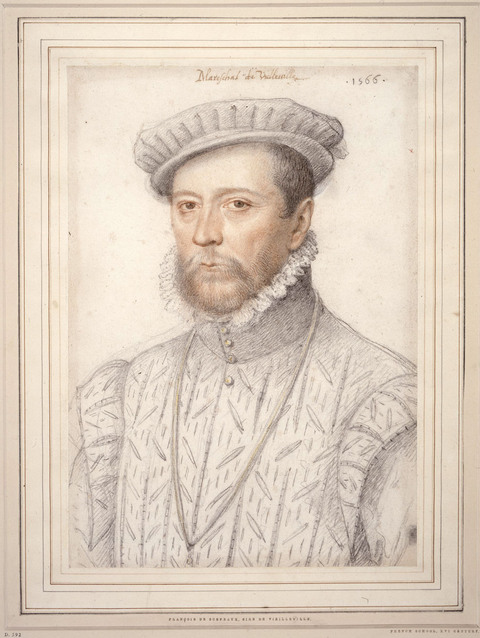
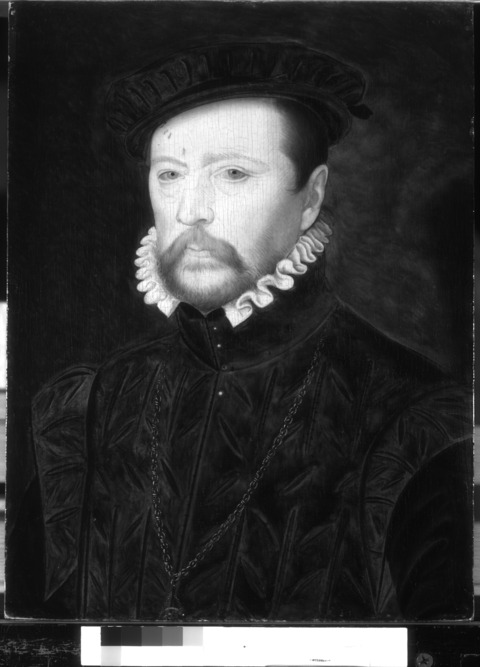
Medium/Technique:
The composition was planned in detail prior to paint application. Given its comparable size and identical resemblance to a colored chalk drawing attributed to Franҫois Clouet in the British Museum collection, it is likely traced from a preparatory drawing (compare tech. fig. 7 & tech. fig. 8). Infrared reflectography of the painting strongly supports evidence of a traced underdrawing in dry media as primary contours are concisely outlined and there is an absence of adjustments one would expect from a more freehand approach. Stylus marks were not identified on the British Museum’s drawing,8 and it is therefore unlikely that that drawing served as the template for the IMA painting. However, a direct-copy method from another template is likely.
The infrared reflectogram shows a highly developed underdrawing within the sitter’s face that appears to be executed in dry media (see tech. fig. 8). The range in values observed throughout the drawing suggests that more than one drawing material was used. Further analysis is necessary to accurately characterize the media; however, given that the portrait exists as a colored chalk drawing that is presumably by the same hand, one might expect to find black chalk as a component of the underdrawing. Contours and form are detailed through a combination of fine and bold lines delineating the curves of facial features as well as the pleats within the ruffled collar. Hatch marks slanting primarily downwards from right to left establish passages of shadow and blended shading within the eyes and ear. The subtle gradation of value that appears as shading within the infrared reflectogram cannot be exclusively attributed to the underdrawing, but likely relates to the combined visual effects of the underdrawing, a thin monochromatic underpainting, and the upper paint layers. The underdrawing cannot be detected within the sitter’s costume due to overlying layers of infrared-absorbent black paint. However, compositional planning is expected throughout the entire composition.
Pentimenti:
As the transparency of the paint has increased with age, passages of the underdrawing have become visible through the thinly painted skin tones (tech. fig. 9). Generally, the artist did not deviate from the original design; however, slight adjustments were made to the contour of the hat’s upper rim. This minor costume alteration appears to have been executed during the painting stage, and although it is visible to the unaided eye, it is more pronounced in the infrared reflectogram (see tech. fig. 8).
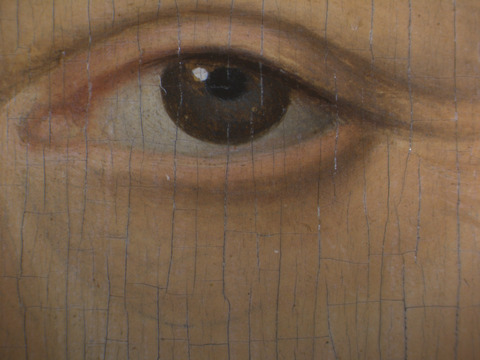
Description of Paint
Analyzed Observed
Application and Technique:
Paint application ranges from scumbled and glazed layers devoid of prominent brushwork in the skin tones to broad gestural brushwork within the background and costume. Visual examination indicates that, as the artist began to work the underdrawing into a finished painting, he employed loose brushwork and paint ranging in consistency from translucent pellicular to paste vehicular to block in the colors of the clothing and background following the drawing’s established contours. The initial paint layer—a thin translucent wash—allows the ground to show through the brushwork, and as the surface was built up with successive layers of paint, saturation and opacity increased to further establish form, depth, and detail throughout the composition. The transition between translucent wash to opaque paint can be observed overall, but it is most pronounced within the background and tunic.
Aside from the individual delicate strokes of paint denoting hair, brushwork is not visible within the skin tones. The artist appears to have employed a slightly different technique to develop form within the facial features by first painting a thin, dark monochromatic underpainting beneath shadows and midtones. Successive layers of very thin, light, opaque paint was then applied, allowing each layer to dry fully before applying the next, to create a soft transition from shadows to highlights. Thin pellicular washes/glazes of brown and reddish-brown emphasize details and form around the eyes, nostrils, lips, and ears. Towards the end of the painting process, the facial hair and contours of the tunic, hat, and collar were reinforced with tapered, fluid lines of paint applied with a fine-tipped brush. These brushstrokes are visible in the infrared reflectogram (black and gray within the costume and facial hair), X-radiograph (white within the collar), and raking and specular illumination (slight ridges around contours). The buttons, chain, and pendant were detailed during the final stage of painting with comparatively thick opaque paint that shows as slight impasto under raking illumination. Cross-section analysis was not completed to confirm what visual observation suggests about the artist’s technique; however, future analysis would provide valuable insight into the structure and components of the paint layer.
Painting Tools:
Paint application ranges from soft gestural brushwork throughout the background and within the costume, to individual tapered lines in the hair and highlights, to a smooth surface completely void of brushwork in the skin tones. The absence of distinct bristle marks overall indicates that the paint was likely applied with both flat and fine-tipped natural hair brushes ranging in size from medium to very fine.
Binding Media:
Visual characteristics of the paint suggest that the artist used an oil-based binding medium overall, but analysis is necessary to confirm the binding media.
Color Palette:
The artist employed a simple color palette of red, yellow, white, brown, black, and gray-green. XRF analysis suggested the presence of lead white, vermilion, lead-tin yellow, iron oxide (earth pigments), bone black, and copper-containing green and/or blue pigment (tech. fig. 12).
The skin appears to have been painted using lead white and iron oxide (earth pigments) with the addition of vermilion. The bold yellow buttons and chain are painted using lead-tin yellow for the highlights and likely yellow ochre for the shadows (tech. figs. 10, 11). The inscription also appears to contain a small amount of lead-tin yellow, likely mixed with lead white. The cloak of the figure is painted using bone black and perhaps carbon black mixed with iron oxide (earth pigments) and a copper-containing pigment, probably a green, such as copper resinate, or perhaps blue, such as azurite. The background of the figure uses a similar combination of pigments to the cloak but with ratios manipulated to create a modulated passage of grayish-green paint, rather than a dark black.
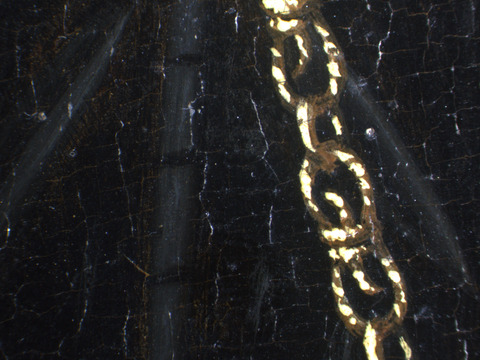
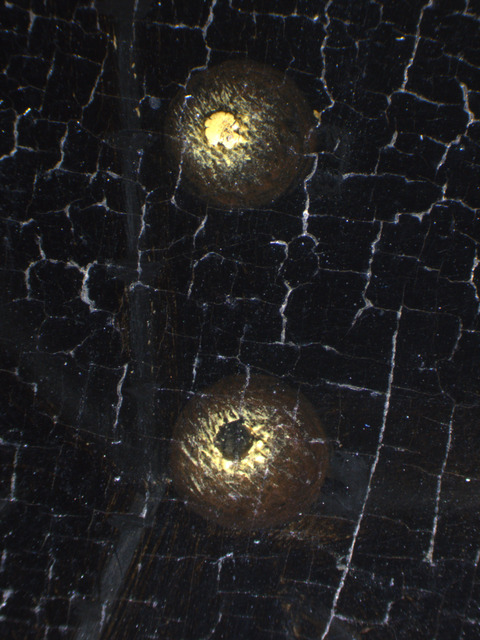
XRF Analysis:
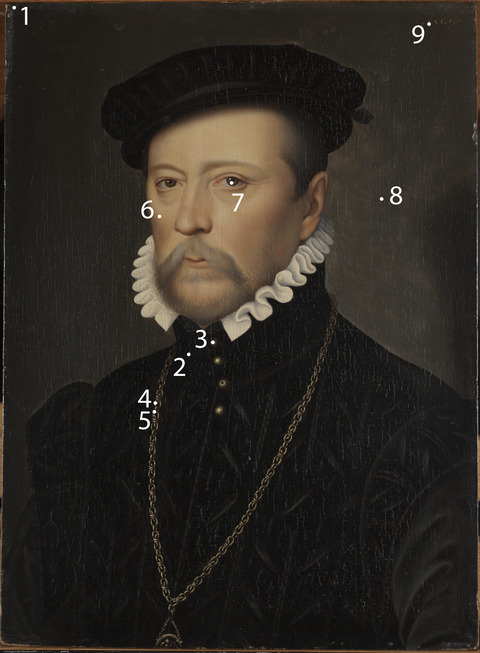
| Sample | Location (H×W from bottom-left corner) | Elements | Possible Pigments |
|---|---|---|---|
| 1 | Ground in top-left corner | Major: Pb, Ca Minor: Cu, Fe Trace: | Calcium (from ground layer), lead white, trace of iron oxide (earth pigments). |
| 2 | Black cloak | Major: Pb, Cu, Ca Minor: Sr Trace: Fe, P | Lead white, bone black, possible carbon black, copper-containing green and/or blue pigments, trace of iron oxide (earth pigments), calcium (from ground layer). |
| 3 | Yellow button | Major: Pb, Ca Minor: Sn Trace: Cu, Fe | Lead white, lead-tin yellow, trace of copper-containing green and/or blue pigments, trace of iron oxide (earth pigments), calcium (from ground layer). |
| 4 | Chain highlight | Major: Pb Minor: Sn Trace: Cu, Fe. Ca | Lead white, lead-tin yellow, trace of copper-containing green and/or blue pigments, trace of iron oxide (earth pigments), calcium (from ground layer). |
| 5 | Chain shadow | Major: Pb Minor: Fe, Cu Trace: Ca | Lead white, iron oxide (earth pigments), copper-containing green and/or blue pigments, calcium (from ground layer). |
| 6 | Skin | Major: Pb Minor: Fe, Hg Trace: | Lead white, iron oxide (earth pigments), vermilion |
| 7 | Eye | Major: Pb Minor: Fe, Trace: Hg, Ca | Lead white, iron oxide (earth pigments), trace of vermilion, calcium (from ground layer). |
| 8 | Background | Major: Pb Minor: Fe, Cu Trace: Ca | Lead white, iron oxide (earth pigments), copper-containing green and/or blue pigments, calcium (from ground layer). |
| 9 | “1” on inscription | Major: Pb Minor: Fe, Cu Trace: Ca, Sn | Lead white, iron oxide (earth pigments), copper-containing green and/or blue pigments, calcium (from ground layer), trace of lead-tin yellow. |
Table 1: Results of X-ray fluorescence analysis conducted with a Bruker Artax microfocus XRF with rhodium tube, silicon-drift detector, and polycapillary focusing lens (~100 μm spot).
*Major, minor, trace quantities are based on XRF signal strength not quantitative analysis
Surface Appearance:
The overall surface appears uniform, thin, and even under visible light and at normal viewing distance; however, close inspection shows that the paint layer utilizes a very low impasto in the highlights of the buttons and around major contours of the composition. The thicker, medium-rich paint can be detected as soft ridges under extreme raking and specular light. A prominent network of vertical age craquelure that coincides with craquelure observed in the ground is present overall.
Condition of Paint
The paint layer is secure and in relatively good condition showing strong cohesion between layers and strong adhesion to the ground. Despite exhibiting a prominent network of vertical age craquelure that coincides with that observed throughout the ground, and hallmarks of past minor insecurities that resulted in loss, no sign of incipient or active delamination was observed. Two anomalous sigmoid cracks beneath the sitter’s proper right eye9 and three small areas of old compensation within the sitter’s proper-right forehead10 suggest that past lifting and loss within the picture layer was addressed through consolidation, fill application, and inpainting. Past treatment proved successful in stabilizing and visually reintegrating passages of damage with the surrounding original colors, but these may have also altered vulnerable areas of the paint’s surface during the process. There is flattened impasto and loss of the opaque yellow paint used to denote the buttons on the tunic collar (tech. fig. 11). This distortion and loss may relate to storage conditions early in the painting’s life where the portrait may have been stored under a heavy object before the thicker paint had time to fully dry. Alternatively, a consolidation campaign that utilized heat and pressure to soften and flatten rigid lifting paint may have damaged the raised impasto. Although the former is possible, the latter also offers a plausible explanation for the anomalous mechanical cracks noted beneath the eye, i.e., where pressure was applied to rigid lifting paint before it had adequate time to soften.
Description of Varnish/Surface Coating
Analyzed Observed Documented
| Type of Varnish | Application |
|---|---|
| Natural resin | Spray applied |
| Synthetic resin/other | Brush applied |
| Multiple Layers observed | |
| No coating detected |
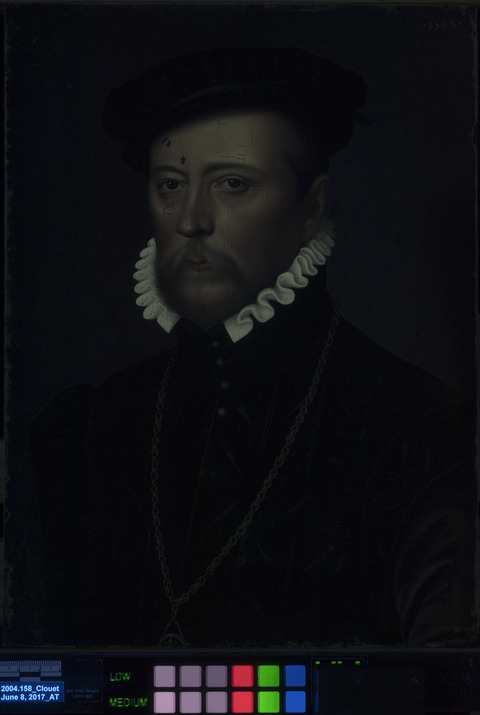
The painting has been varnished with a synthetic resin that does not fluoresce under ultraviolet induced visible fluorescence (tech. fig. 13). Some inpainting is discernable as dark spot in the lighter areas of the painting.
Condition of Varnish/Surface Coating
In 2016/2017, multiple surface coatings including a natural resin varnish and a coating of wax were removed, and the painting was varnished using a multilayered structure of synthetic resin coatings (see tech. figs. 14, 15). A preliminary barrier of filtered 20% Paraloid B-72 (in xylenes: Shellsol A100; 7:2) was applied before inpainting. Inpainting was executed using dry conservation-grade pigments bound in polyvinyl acetate 40% AYAA: AYAC (2:1 in 1-methoxy-2-propanol).
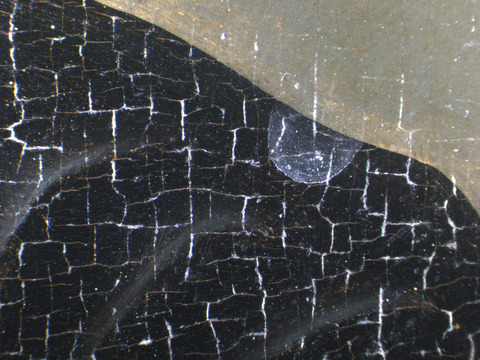
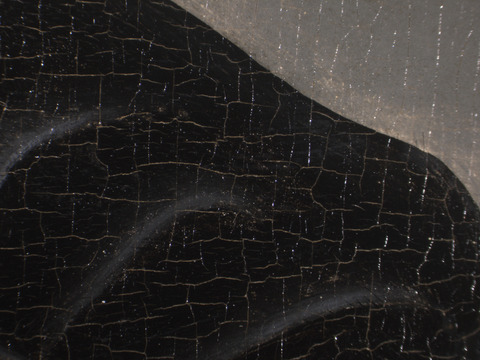
Description of Frame
Original/first frame
Period frame
Authenticity cannot be determined at this time/ further art historical research necessary
Reproduction frame (fabricated in the style of)
Replica frame (copy of an existing period frame)
Modern frame
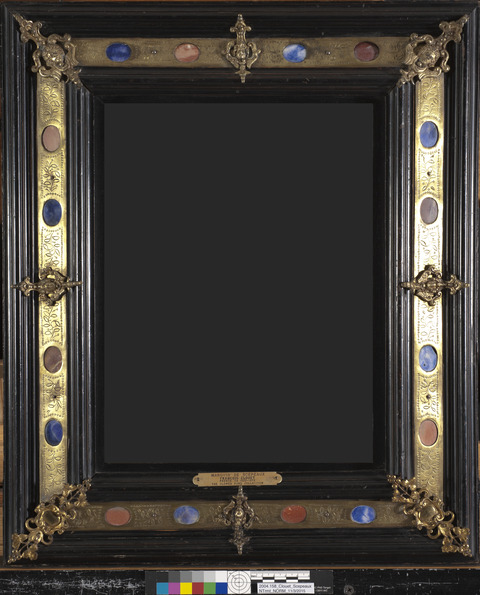
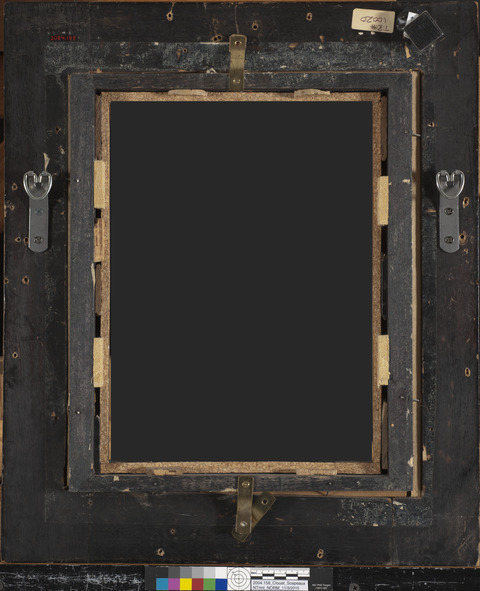
Frame Dimensions:
Outside frame dimensions: 48.5 × 41 × 2.5 cm
Sight size: 30.5 × 23 cm
Distinguishing Marks:
Item 7. Indianapolis Museum of Art accession number painted in red in the top-left corner: “2004.158” (tech. fig. 17)
Item 8. Off-white sticker on right side of top member with a handwritten (ink) temporary receipt number: “T.R. # / 10020” (tech. fig. 17)
Description of Molding/Profile:
Per examination notes completed by Timothy Newbery, the front of the frame is composed of ebonized moldings ornamented with pierced brass and thin stone cabochons in the frieze and centered corner applique (tech. fig. 18). The molding profile is as shown in technical figure 18; the reverse is painted black and the rebate opened.11
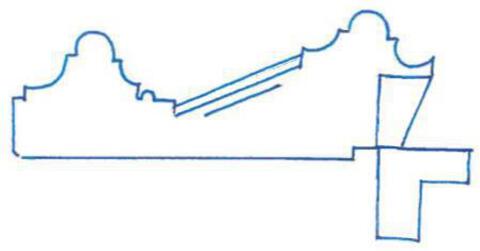
Condition of Frame
The frame appears stable at this time and provides adequate housing for the painting. Numerous old areas of minor abrasion and loss have occurred to the ebony finish. The metal elements show some minor distortions, which also appear to be old.
In 2019, a build out was added to the back of the frame to accommodate a microclimate chamber around the painting. The painting was fitted to a microclimate chamber made of a single sheet of Optium acrylic glazing with a two-ply mat backing board and sealed with foil tape and Marvel-seal backing.
Notes
-
Paul A.J. Spheeris, “Conservation Report on the Condition of the Clowes Collection,” 25 October 1971, Conservation Department Files, Indianapolis Museum of Art at Newfields. ↩︎
-
Martin Radecki, Clowes Collection condition assessment, undated (after October 1971), Conservation Department Files, Indianapolis Museum of Art at Newfields. ↩︎
-
Memorandum from Carl J. Weinhardt to Martin J. Radecki titled “Charges for Conservation of Objects in the Clowes Collection”. 15 Feb 1974. Collection Clowes, Clowes Conservation Department Files, Indianapolis Museum of Art at Newfields. ↩︎
-
Memorandum from Carl J. Weinhardt to Martin J. Radecki, “Charges for Conservation of Objects in the Clowes Collection,” 15 February 1974, Conservation Department Files, Indianapolis Museum of Art at Newfields. ↩︎
-
David Miller, handwritten notes on treatment, C10020 (2004.158), 4 January 1982, Conservation Department Files, Indianapolis Museum of Art at Newfields. ↩︎
-
Peter Klein, dendrochronological analysis report, C10020 (2004.158), 25 June 1999, Conservation Department Files, Indianapolis Museum of Art at Newfields. ↩︎
-
Locations as measured height × width from the painting’s bottom-left corner: 25.0 × 8.0 cm; 24.7 × 8.2 cm; 24.0 × 8.8 cm. ↩︎
-
Correspondence from A. V. Griffiths, Keeper, The British Museum Department of Prints and Drawings to Jacquelyn N. Coutré, IMA, dated 14 April 14 1999: “I have looked carefully at our original drawing, and can tell you that there is no trace of any stylus around the contours. It is drawn in colored chalks, and gives every impression of being a finished work. As you doubtless realize, it forms part of a series which was originally contained in a single album.” ↩︎
-
Located at 21.2 cm × 8.0 cm as measured height (H) by width (W) from the bottom-left corner. ↩︎
-
Located at 25.0 cm × 8.0 cm; 24.7 cm × 8.2 cm; and 24.7 cm × 8.2 cm as measured height (H) by width (W) from the bottom-left corner. ↩︎
-
Newbery notes that the frame is “possibly based on a Spanish 17th-century reliquary frame (eg. Monastario de la Encarnacion, Madrid). However, the woodwork finish and stone cabochons suggest a late 19th-century version made in Spain or Italy.” Timothy Newbery, frame specialist, London, England. Visual analysis completed at the Indianapolis Museum of Art, 16 January 2012. ↩︎
Additional Images
